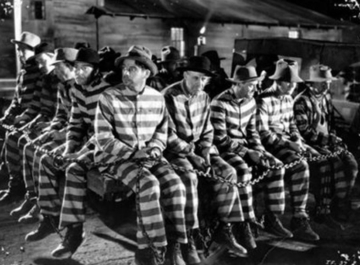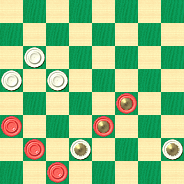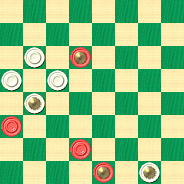The Fugitive Companion

It looks like these fugitive companions didn't get very far. They're all on their way back to the big house, and they'll probably stay there for a long time.
Today's Checker School column features a pair of related problems, neither of them especially easy, but as usual, quite instructive. You'll see where the title comes from when you work them through.
F. DUNNE
WHITE

BLACK
Black to Play, White Draws
B:W24,20,19,K7,K5:BK14,12,K10,8,3.
Diagram Two
McKEAN - WARDROP
WHITE

BLACK
Black to Play and Win
B:W24,20,19,K16,K1:BK23,12,7,K2.
Can you solve these problems, or will you just flee, with or without a companion? While not easy, they may not be as hard as you might think at first glance. Recapture your solutions and then click on Read More to see a sample game and the solved problems with detailed notes.![]()
Solutions
Lettered notes and commentary are by Ben Boland in Famous Positions in the Game of Checkers. Numbered notes are by the editor, using the KingsRow computer engine and 10-piece endgame database.
Diagram No. 1: 8-11---1, 7-16, 10-7---A, 5-1, 14-10, 1-5, 3-8, 5-9, 8-11, 9-5, 11-15, 5-9*---B, 15-18, 19-15*---2, 10-28, 9-14, 12-19, 14-16, 28-24, 16-12, 24-19, 20-16. Drawn---3.
Diagram No. 2: 7-10, 1-5, 2-6, 5-1, 6-9, 1-5, 10-14, 5-1, 14-17---4, 1-5, 9-14---5, 5-1, 14-10, 1-5, 17-22, 5-9, 22-26, 9-5, 26-30, 5-1, 30-26, 1-5, 26-22, 5-9, 22-18, 9-5, 18-15, 5-9, 23-18---6, 9-5, 18-14, 5-1, 14-9, 1-5, 9-6, 5-1, 6-2, 1-5, 10-14. Black Wins---7.
Game: 11-16, 22-18, 7-11, 24-19, 3-7, 25-22, 11-15, 18-11, 8-24, 28-19, 4-8, 29-25, 8-11, 22-18, 9-14, 18-9, 5-14, 26-22, 16-20, 22-18, 1-5, 18-9, 5-14, 25-22, 11-15, 32-28, 15-24, 28-19, 7-11, 22-18, 11-16, 18-9, 6-13, 30-26, 10-14, 19-15, 16-19, 23-16, 12-19, 15-11---E, 19-24, 26-22, 2-6, 11-7, 24-28, 27-23, 28-32, 7-2, 6-9, 2-7, 20-24, 23-19, 32-27, 19-16, 27-23, 16-12, 23-26---G, 7-10, 26-17, 12-8, 24-28, 8-3, 28-32, 3-8, 32-28, 8-11, 28-24, 11-16, 24-28, 16-19, 28-32, 19-23, 32-28, 23-26, 28-24, 26-30, 24-28, 31-26, 28-24, 10-15, 24-28, 15-19, 28-32, 19-23, 32-28, 30-25, 28-24, 25-22, 24-28, 22-18, 28-24, 18-15, 24-28, 23-27, 28-32, 27-31, 32-28, 15-10, 28-32---F, Forms Diagram No. 2, colors reversed. R. D. Banks.
A---3-7, 5-1, 14-18, 1-5, 10-6, 5-1, 6-2, 1-5, 18-23, 5-1 (5-9 is Note F colors reversed). Forms Diagram No. 2.
B---This corrects McKechanie who played: 5-1, 15-18, 1-5, 18-22, 5-9, 22-25, 9-5, 25-29, 5-1, 29-25, 1-5, 25-22, 5-9, 22-18, 9-5, 18-15---C, 5-1---D, 7-2, 1-5, 10-14, 19-10, 12-28. Black Wins.
C---10-14, 5-1, 18-23, 1-6, 7-2, 6-1, 14-10, 1-5, 2-6, 5-1, 6-9, 1-5, 9-14, 5-1, 14-18, 1-5, 18-15, 5-9, 23-18, 9-5, 18-14, 5-1, 14-9, 1-5, 9-6, 5-1, 6-2, 1-5, 10-14, 19-10, 12-28. Black Wins. T. Wardrop.
D---5-9, 7-2, 9-13, 2-6, 13-17, 6-9, 17-22, 9-14, 16-11, 15-8, 22-18. Drawn. D. Robertson.
E---In Wood's Studies No. 68 at Note F, 15-10 is played and Black draws the ending a piece down.
F---28-24 would draw: 28-24, 26-23, 24-20*, 31-27, 20-16, 27-24, 16-11, 24-20, 11-7*, 10-3, 17-22, 20-24, 22-18, 24-27, 18-15, 27-32, 15-10, 32-28, 10-6 3-7, 6-1, 28-24, 1-5, 24-27, 18-14, 23-14, 9-18, 7-10, 18-22, 27-23, 5-9, 10-15, 22-25, 23-18, 25-30, 18-22, 9-14, 15-19, 14-10, 19-23, 10-14*. Drawn. Position No. 36, May 1903, "Guide Post."
G---23-19, 7-10, 19-16, 10-17, 16-11, 22-18, 13-22, 21-17, 9-13, 17-14. Drawn. A. J. Temple and R. D. Banks.
1---14-9 is the computer move and also leads to a draw after 7-14 9-18 5-9 8-11 19-15 etc. Black's try with 8-11 pitches a man in order to hold White in a very awkward formation.
2---The only way out is to momentarily give two men back!
3---If Black plays 7-3 then 16-11 19-15 11-8 15-11 8-4 is still a draw as Black doesn't have the move.
4---Or 14-17.
5---Or 9-6.
6---With the Black king positioned at 16, the King at 23 is finally released from guard duty.
7---19-10 12-28 5-1 14-7. This is not a simple double corner win, and the techniques used are well worth learning.
We learn from the Scottish Draughts Quarterly, June 1898: It is over 12 years since the position (Diagram No. 1) was first published in the Liverpool Courier, under the name of the late Charles McKechanie, who arrived at it from a Cross Game, played in a little "International" Match, Scotch v. English.
By an oversight, the terms attached to the position read "Black to Move and Draw," instead of "Win," as was intended. Then, as now, critics were keen on corrections, and it surprised no one when a correction appeared in the Leed's Mercury the following Saturday. Of course the terms were amended in the Courier, see Note B.
After the lapse of a few weeks D. Robertson took up the position in the Glasgow Herald, and showed a draw, see Note D. Several more weeks passed, when T. Wardrop restored the Black Win in the Herald, see Note C. Then in the Courier of Feb. 20, 1886, the position was reset under the name of Frank Dunne, with the terms and solution as given above. Mr. Dunne wrote: "My attention has been redirected to this position owing to Mr. D. Robertson, of Glasgow, having published play in the Glasgow Herald showing a neat draw, which occurs nearly at the end of Mr. McKechanie's solution. Upon a careful examination, I have come to the conclusion that, after all, Black cannot force a Win, and I therefore beg to submit the problem again, with an extended solution, showing, I think, a draw for White against every line of attack that can be adopted by Black." See Diagram No. 1.
It is curious to note that Mr. Dunne in publishing his Guide entirely overlooked his own correction of the McKechanie position. The problem is there given as No. 39 under Mr. McKechanie's name, with the terms as originally intended "Black to Move and Win."
Diagram No. 2 appeared as Nos. 36 and 37, May 1903, issue of the Guide Post, under authorship of the late Hugh McKean, in an effort to correct the late C. McKechanie and F. Dunne. McKean reaches this position by playing 3-7 instead of 3-8, see Note A. Note too, that he uses Wardrop's method in obtaining the Win, see Note C. With the King on 5 instead of 1, with White to Play it is only a draw, see Note F, colors reversed.
The above game was published in the Advocate, Mr. Sterling, Kentucky, May 5, 1936, Game 308. It was played by mail between A. J. Temple and R. D. Banks. The latter pointed out the above position if 23-26 were played at G.
Compare to "The Fugitive King," Page 135 (In the original book and as previously published by The Checker Maven---Ed.).
You can email the Webmaster with comments on this article.